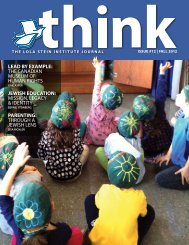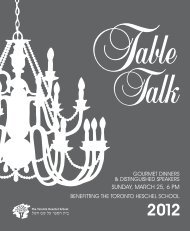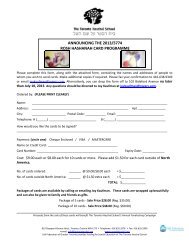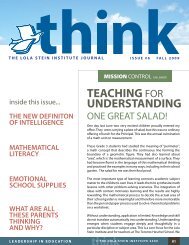Issue No. 13 - The Toronto Heschel School
Issue No. 13 - The Toronto Heschel School
Issue No. 13 - The Toronto Heschel School
You also want an ePaper? Increase the reach of your titles
YUMPU automatically turns print PDFs into web optimized ePapers that Google loves.
THINK INTERVIEW<br />
INSPIRING TEACHERS<br />
<strong>The</strong> Natural Bible:<br />
AN INTERVIEW WITH AUTHOR BARUCH SIENNA<br />
Baruch Sienna is an environmental Jewish educator,<br />
technologist, and graphic designer who combines his passion<br />
for nature, art, and education to create Jewish digital art and<br />
innovative publications. After years of research and work in<br />
<strong>Toronto</strong> and at <strong>The</strong> <strong>Heschel</strong> Center For Environmental Learning<br />
and Leadership and at Neot Kedumim, the Biblical Landscape<br />
Reserve in Israel, Sienna has published <strong>The</strong> Natural Bible.<br />
Why did you write this book?<br />
Today, global climate change, pollution, and habitat destruction<br />
are critical problems facing us all. If Judaism is to continue to be<br />
relevant, it must speak to this environmental crisis. I think Jewish<br />
environmental values have a lot to teach us about how to develop<br />
a healthier relationship with the earth. My book includes essays on<br />
what our classical Jewish sources teach about sustainability and<br />
stewardship of natural resources and our relationship to animals.<br />
It also suggests how Shabbat can be a model for living more<br />
ecologically.<br />
Awakening an appreciation of the natural world of the land of Israel<br />
is crucial in order to connect in a fundamental way to Judaism. I<br />
felt that most Jewish environmental books were missing this link.<br />
Living in an urban setting in Canada, we often are disconnected<br />
from our own natural setting, and even more disconnected from<br />
the nature and land of Israel.<br />
It is challenging to connect to the Jewish calendar, for instance, to<br />
celebrate spring on the Jewish holiday of Tu BiSh’vat when we are<br />
in the middle of winter. Also, we sometimes do not understand how<br />
the Bible uses the natural world symbolically. For example, many of<br />
us do not know that the palm, myrtle, willow, and citron (etrog),<br />
which comprise the Four Species of Sukkot, relate in a special<br />
way to the landscape of Israel, and to rain and water. <strong>The</strong>se plants<br />
represent victory, immortality, regeneration, and luxury. Knowing<br />
these associations enhances the meaning of the ritual.<br />
Why an iPad iBook? I began this project as an interactive,<br />
multimedia project because technology can be leveraged to make<br />
learning more engaging. Although we call this a “book” because<br />
that is what we are used to, the iPad iBook platform is much more<br />
powerful than a traditional book. <strong>The</strong> entire text is searchable, and<br />
the built-in glossary and dictionary make the meaning of any word<br />
accessible at the tap of a finger. Pages can be bookmarked and text<br />
highlighted. You can even write notes in the margin and create<br />
study cards. <strong>The</strong> iPad allows for audio, multimedia, and interactive<br />
quizzes.<br />
My favourite page is in the essay about the Jewish calendar, where I<br />
explain how the Jewish month stays synchronized with the phases<br />
of the moon. I thought, wouldn’t it be great if I could include a<br />
picture of the moon’s phase the way it looks tonight in the sky. This<br />
book does that.<br />
Why would the community be interested in<br />
this book? Many years ago, I began this project as part of an<br />
innovative initiative of the Board of Jewish Education with a modest<br />
grant to work with teachers from <strong>The</strong> <strong>Toronto</strong> <strong>Heschel</strong> <strong>School</strong>. It<br />
made perfect sense to partner with a school that already is a leader<br />
in environmental Jewish education. We grossly underestimated<br />
how large a project this would be and how the technology we<br />
had at the time (CD-ROMs) was neither sufficiently powerful nor<br />
sophisticated to actualize the project. I never gave up, and when<br />
the iPad became available, I realized that the project was feasible<br />
for the first time. This book will be a valuable resource for teachers,<br />
parents, and (upper-level) students, linking classical Jewish texts<br />
with environmental sensibility and sensitivity.<br />
What message do you hope the book leaves<br />
with the readers? I believe passionately that insights<br />
from Jewish texts can instill in us a respectful and reverent attitude<br />
towards the earth. Reciprocally, appreciating the natural world<br />
can help us better understand biblical sources and connect more<br />
deeply with Jewish tradition. I hope this guide will help readers<br />
build a bridge between our Jewish heritage, Jewish ethics, and the<br />
natural world.<br />
How can our readers learn more? <strong>The</strong>y can<br />
visit www.thenaturalbible.weebly.com to learn more, or they can<br />
download a free sample from the Apple iBookstore at http://bit.ly/<br />
XK9n2E and http://bit.ly/XK9n2E<br />
Remembering Rabbi Weiss<br />
As someone who has taught for the last 38 years and who constantly<br />
assesses his own teaching skills, I often think back on the teachers<br />
who made the greatest impression on me as a student. I had a few<br />
stellar teachers in university and one or two who stood out among<br />
my instructors at the Yeshiva in Israel. But even today, in my sixties,<br />
at the top of the list is my Grade 5 Hebrew and Jewish studies<br />
teacher, Rabbi Yehudah Weiss.<br />
Only many years after Rabbi Weiss was my teacher did I learn<br />
how tragic his early life had been. He had lost a wife and a young<br />
daughter in the Holocaust. He tried to rebuild his life in Israel after<br />
the war and married again. But, like many people, he found life in<br />
the new state difficult, and so he came to Canada to teach at the<br />
Associated Hebrew <strong>School</strong>s.<br />
In Grade 5, it would never have crossed my mind that this man<br />
could have had a tragic past. For me, he was a compassionate man<br />
who loved children and who knew how to get them to learn and to<br />
laugh.<br />
Rabbi Weiss was the consummate raconteur, teaching through<br />
stories that he invented. <strong>The</strong> heroes of his stories were often day<br />
school children who knew more about Judaism than the adults<br />
around them. We loved those stories and it was obvious that he<br />
was trying (and succeeding!) to get us to recognize the value of the<br />
education that we were receiving.<br />
Another set of stories that Rabbi Weiss loved to tell involved Gveret<br />
Shabbat (Mrs. Shabbat) and her feelings about accommodating<br />
guests in her home. Often Gveret Shabbat was very obliging to<br />
her guests. Although she liked to eat three meals a day, whenever<br />
Mr. Yom Kippur came to visit her, she joined him in his fast. And<br />
although she liked to eat challah at her meals, when Mr. Pesach<br />
came to visit she happily substituted matzah for the challah. But<br />
if Mr. Pesach pulled out a cigarette and wanted to smoke in her<br />
house, she told him that guests in her home were not allowed to<br />
smoke. And whenever the morose Mr. Tisha B’Av came to visit her,<br />
bemoaning the destruction of the Temple, Gveret Shabbat firmly<br />
but politely sent him next door, to the home of her neighbour, Mrs.<br />
Sunday. We used to laugh at these stories but at the same time we<br />
learned many details of Jewish law: the fast of Yom Kippur can fall<br />
on Shabbat and override Shabbat, but the fast of Tisha B’Av cannot.<br />
Smoking is not permitted on Shabbat but is permitted on a holiday,<br />
like Pesach. (Yes, back in the sixties, Jewish day school students<br />
were being taught that smoking was permitted six days a week.)<br />
<strong>The</strong> Gveret Shabbat stories also taught us lessons about how to treat<br />
guests. We learned that hosts should be accommodating, but that<br />
there are limits!<br />
Rabbi Weiss understood that teaching has to be at least partly<br />
entertainment. Every once in a while when he saw that we were<br />
having trouble concentrating on a difficult text, he would take out<br />
By Martin Lockshin<br />
some cellophane or shiny paper (yes, occasionally it was the liner<br />
paper from his package of cigarettes) and build before our eyes a<br />
pelican or some other animal, totally unconnected to our lesson.<br />
But after such a show, somehow we were always more willing to get<br />
back to our serious studies.<br />
As an 11 year-old, what appealed to me most about Rabbi Weiss’<br />
teaching was his sense of humour and his sincere love of us children.<br />
As I grew older and continued with my studies, I realized that Rabbi<br />
Weiss had another great advantage over most of my other teachers,<br />
one that I could not have figured out as an 11 year-old. Rabbi Weiss’<br />
level of knowledge about Judaism in particular, and about the world<br />
in general, was far beyond what he really needed to teach Grade 5.<br />
He was a true intellectual. Had he lived a few decades later, perhaps<br />
he would have been a very successful professor (and the Associated<br />
students would have been the poorer for it).<br />
I believe that students, even elementary school students who have<br />
no real way of measuring the knowledge of an instructor, still can<br />
and do sense whether depth is there. At any level of instruction,<br />
students are bound to ask questions that are not part of the<br />
lesson plan. Teachers can answer well only if they have a high level<br />
of expertise in the subject matter. I believe it was this depth of<br />
understanding that made Rabbi Weiss so successful at conveying<br />
his love for Judaism and Jewish texts to us.<br />
Teachers at such a high level can potentially set very high standards<br />
for their students. And Rabbi Weiss did. As far as I remember, he<br />
never uttered one sentence in English to our class. He insisted that<br />
we too speak Hebrew. He may have used the occasional English<br />
word to translate a particularly difficult Hebrew word. But I can<br />
remember that many of us used to even wonder how good his<br />
English was. (It was fine, I later learned.)<br />
Sadly, the end of Rabbi Weiss’ life was almost as tragic as the<br />
beginning. He and his wife brought up two sons here in <strong>Toronto</strong>.<br />
<strong>The</strong> younger one, Meir, made aliyah as a teenager and joined the<br />
Israeli army. In the Yom Kippur War, Meir Weiss, of blessed memory,<br />
was killed in action. It was some 30 years after Rabbi Weiss had lost<br />
his first family to the Nazis.<br />
Yet despite adversity that he faced, Rabbi Weiss, the consummate<br />
professional, was a source of joy and entertainment and of truly<br />
deep knowledge for his students. I was just one of many elementary<br />
school students who kept up with him for the rest of our lives. He<br />
touched many people and his legacy lives on.<br />
Martin Lockshin is Chair of the Department of Humanities and<br />
a past Director of the Centre for Jewish Studies at York University<br />
in <strong>Toronto</strong>. He is interested in tradition and innovation, and writes<br />
widely on “modern Orthodoxy.”<br />
16 think • issue <strong>13</strong> • SUMMER 20<strong>13</strong> 17






